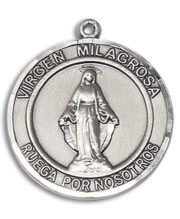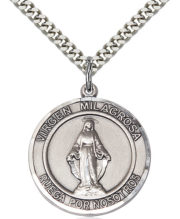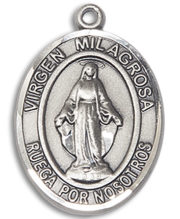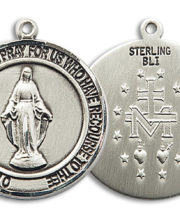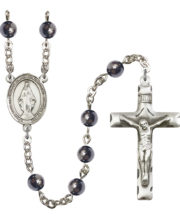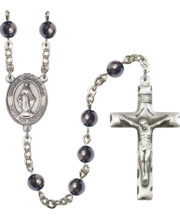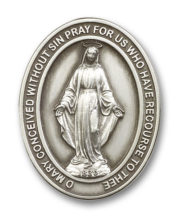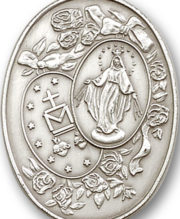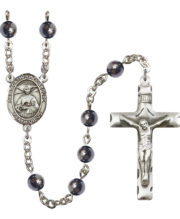Saints
St. Catherine Laboure & The Miraculous Medal
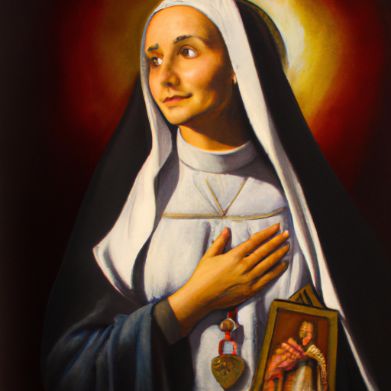 St. Catherine Laboure was a French nun and mystic who lived in the 19th century. She was born on May 2, 1806 in Fain-les-Moutiers, France, and was the ninth of eleven children. Her parents were farmers, and from a young age, Catherine showed a deep religious devotion and a love for prayer.
St. Catherine Laboure was a French nun and mystic who lived in the 19th century. She was born on May 2, 1806 in Fain-les-Moutiers, France, and was the ninth of eleven children. Her parents were farmers, and from a young age, Catherine showed a deep religious devotion and a love for prayer.
In 1827, at the age of 21, Catherine entered the Daughters of Charity of St. Vincent de Paul, a religious congregation dedicated to serving the poor. She took her vows as a nun in 1831 and was sent to the Motherhouse of the Daughters of Charity in Paris to begin her training. While there, she experienced a number of spiritual visions, including one in which the Virgin Mary appeared to her and asked her to have a medal struck in honor of the Immaculate Conception. This medal, which is now known as the Miraculous Medal, depicts Mary standing on a globe with her arms outstretched, and was soon distributed widely, with many reports of miraculous healings and conversions attributed to it.
Catherine’s visions were not always well received by her superiors, and she spent much of her early religious life being questioned and doubted by them. However, her humility, devotion, and strong faith eventually won them over, and she was given permission to share her experiences with others.
In 1836, Catherine was sent to the Daughters of Charity’s school in Paris, where she worked as a nurse and a teacher for the next 30 years. During this time, she continued to experience spiritual visions and received many private revelations from the Virgin Mary, which she shared with only a few trusted confidants.
In 1876, Catherine fell ill and was forced to retire from her work at the school. She died on December 31 of that year, at the age of 70. Despite her relatively short period of public ministry, her spiritual influence continued to grow after her death, and in 1933, she was canonized by the Catholic Church. Today, she is venerated as one of the saints of the Church, and her feast day is celebrated on November 28.
Catherine Laboure is known for her devotion to the Virgin Mary and her role in the creation and distribution of the Miraculous Medal. The story goes that in 1830, the Virgin Mary appeared to her on three different occasions, asking her to have a medal struck, showing the Virgin standing on a globe, surrounded by the words “”O Mary, conceived without sin, pray for us who have recourse to thee.”” with a letter “M” surmounted with a cross, and with the hearts of Jesus and Mary on either side of her. The apparitions also included a message encouraging devotion to the Immaculate Conception of Mary, a doctrine that had been recently defined by the Catholic Church.
As a result, the Miraculous Medal became popularly associated with healing, conversion, and other blessings, and it is estimated that millions of medals have been distributed throughout the world. Today, the medal is considered one of the most popular and well-known devotional items in the Catholic Church.
Catherine lived in relative obscurity throughout her life, but her role in the creation and distribution of the Miraculous Medal, along with her devotion to the Virgin Mary, has led to her being recognized as a saint by the Catholic Church, after being canonized in 1933 by Pope Pius XI. Her tomb remains in the motherhouse of the Daughters of Charity in Paris, France and it is a pilgrimage site for many devoted Catholics.
The Life of St. Catherine Laboure
 The bell in the village church in Fain-les-Moutiers, France, rang out on May 3, 1806. The villagers heard the bell as they worked in their fields, in their homes, or in their shops. Without pausing in their work they reflected that within a few minutes there would be a new Christian in the village: the one-day-old daughter of Pierre and Louise Madeleine Labouré. The event seemed worthy of no more than passing notice. This was the ninth Labouré baby to be baptized. Within a few years there would be two more.
The bell in the village church in Fain-les-Moutiers, France, rang out on May 3, 1806. The villagers heard the bell as they worked in their fields, in their homes, or in their shops. Without pausing in their work they reflected that within a few minutes there would be a new Christian in the village: the one-day-old daughter of Pierre and Louise Madeleine Labouré. The event seemed worthy of no more than passing notice. This was the ninth Labouré baby to be baptized. Within a few years there would be two more.
If the ringing of the bell attracted little attention, it was at least more attention than Catherine Labouré would receive during the remainder of her life. She was to live and die in obscurity: ignored, overlooked, held in low esteem. Her mission was to be a great one, but she was to accomplish it in secret. Zoë, as Catherine was called within the family, was only nine and a half years old when her mother died. One day soon after that, the family servant saw her standing on a table, reaching up to embrace a statue of the Blessed Virgin. “It is you then,” Zoë said, “who are going to be my mother.” There were only three girls in the family, while there were eight boys.
The Biography of St. Catherine Laboure
For a time, Marie Louise, the eldest girl, managed the house hold for her father, while Zoë and her younger sister lived with an aunt. After two years Marie Louise went off to join the Daughters of Charity of St. Vincent de Paul, and the two younger girls returned home. At the age of twelve Zoë was put in charge of the house. She had the help of one servant and of her younger sister, Antonine. When Zoë was fifteen the servant left and was not replaced.
In addition to the household work, Zoë often carried meals to her father and his hired men in the fields. Despite the hard work, she walked a mile and a half to Mass every morning, and she fasted two days a week. Her education was completely neglected; she was the only one of the eleven Labouré children who did not go to school.
One day, apparently in a dream, Zoë attended a Mass said by a priest she had never seen before. As he came down from the altar he looked at her with piercing eyes and beckoned to her. Frightened, she ran from the church. On the way home she stopped in to visit an invalid. There, she saw the same elderly, white haired priest. “My child,” said the priest, “it is a good deed to look after the sick. You are running away from me now, but one day you will be glad to come to me. God has plans for you. Do not forget.”
St. Catherine Laboure was born into a holy family
 The significance of this dream did not become apparent till later. Zoë had a strong desire to become, like her sister, a Daughter of Charity, but her father did not wish to give up a second daughter to the society. When she was twenty-two, he sent her to visit her married brother Charles who owned a restaurant in Paris. He thought that this would take her thoughts away from the religious life. She spent a year in Paris but found the life intolerable. Next, she went to visit another brother, Hubert, at Chatillon-sur-Seine. Hubert’s wife, who conducted a fashionable school for young ladies, took a liking to Zoë. She taught Zoë the rudiments of reading and writing and encouraged her religious vocation. One day, in Chatillon, Zoë visited a hospice under the care of the Daughters of Charity. While she waited in the parlor, she was startled by a portrait on the wall.
The significance of this dream did not become apparent till later. Zoë had a strong desire to become, like her sister, a Daughter of Charity, but her father did not wish to give up a second daughter to the society. When she was twenty-two, he sent her to visit her married brother Charles who owned a restaurant in Paris. He thought that this would take her thoughts away from the religious life. She spent a year in Paris but found the life intolerable. Next, she went to visit another brother, Hubert, at Chatillon-sur-Seine. Hubert’s wife, who conducted a fashionable school for young ladies, took a liking to Zoë. She taught Zoë the rudiments of reading and writing and encouraged her religious vocation. One day, in Chatillon, Zoë visited a hospice under the care of the Daughters of Charity. While she waited in the parlor, she was startled by a portrait on the wall.
“Who is that?” she asked the Sister who came to see her. That is our founder, St. Vincent de Paul.” This was the priest Zoë had seen in the dream five years earlier! After that Zoë was more certain than ever of her vocation, and with the help of her sister-in-law she won her father’s reluctant consent, She became a postulant in the House of the Daughters of Charity at Chantillon in January, 1830.
After her probationary period, she was transferred to the novitiate of the Daughters of Charity at 132 (now 140) Rue du Bac in Paris. When she received her habit a went back to her baptismal name and became Sister Catherine April and May, the Sisters made a novena in honor of St. Vincent During this time Sister Catherine saw several visions of St. Vincent’s heart. On Trinity Sunday, 1830, she had a vision of Christ the King She told her confessor, Father Jean Marie Aladel, but he thought her visions were imaginary.
St. Catherine Laboure is Visited by the Blessed Virgin
On July 18, 1830, the eve of the Feast of St. Vincent de Paul Sister Catherine retired with a prayer that St. Vincent would obtain for her the privilege of seeing our Lady. At 11l:30 she was awakened by a child who, in a voice of authority, told her to come to the chapel at once because the Blessed Virgin was waiting for her. Sister Catherine dressed quickly and hurried to the chapel which was ablaze with light. Led by the child, she went to the sanctuary.
The child cried: “There is the Blessed Virgin!” Catherine looked in the direction indicated and saw our Lady, clad in white, advance to the foot of the altar. She sat in the chair ordinarily occupied by the priest while giving a conference to the Sisters. Catherine rushed forward and threw herself to her knees. She rested her clasped hands on the knees of the Blessed Virgin. It was “the sweetest joy of my life,” she said later, “a delight beyond expression.”
“My child,” the Blessed Mother said, “God wishes you to under take a mission. For it you will have much to suffer, but you will overcome that by recalling that you do so for the glory of God… She talked with Catherine for about two hours, telling her many things that were for her ears alone, but also some things for the world at large. She said that the times were evil and that France and the whole world would suffer great calamities, but the two societies founded by St. Vincent – the Daughters of Charity and the Vincentian Fathers – would remain unharmed and would grow.
 The Messenger of Mary
The Messenger of Mary
She was quite specific in some of her forecasts, and Catherine understood that some of the calamities would take place soon and others in about forty years. “My eyes are ever upon you,” our Lady said to Catherine. “I shall obtain many graces for you. Special graces will be given to all who ask for them, but people must pray.”
Catherine said nothing about the vision to her companions. She told only Father Aladel and pledged him to secrecy. He was inclined to disregard her story at first, but he was somewhat shaken when a revolution broke out in Paris a few days later and everything happened as Catherine said Our Lady had foretold. Churches were profaned, convents were pillaged, priests were subjected to great indignities. The mother house in the Rue du Bac shook with gun fire and was surrounded by an angry mob, but, true to our Lady’s word, it remained unharmed. (The other events foretold by our Lady, including the killing of the Archbishop of Paris, were to take place during the War of the Commune, 1871.)
The Origin of the Miraculous Medal
On November 27, 1830, our Lady again appeared to Catherine in the chapel. She stood on a globe with shafts of light streaming down from gems on her fingers. Catherine understood that the globe represented France, the world, and each individual person. The lights represented graces which went to all who asked for them. From some of the gems there were no lights because some people failed to ask for graces.
An oval frame enclosed our Lady, and around the top of the frame were the words: “O Mary, conceived without sin, pray for us who have recourse to thee.” Then the picture turned around and Catherine saw on the reverse side a capital M with a cross above it; below the M were two hearts, one encircled by a crown of thorns, the other pierced by a sword. Catherine heard a voice tell her to have a medal struck on this model, promising great graces to all who wore it.
Striking the First Miraculous Medal
This or a similar vision was repeated several times up to September, 1831. Father Aladel did not know what to do. He did not have the authority to have a medal struck. Besides, it was to say “O Mary, conceived without sin. . .” and the Immaculate Conception was not then declared a dogma of the Church. (The promulgation of this doctrine was to come twenty-four years later.) He prayed for divine guidance and consulted the Archbishop of Paris.
In June, 1832 the first Miraculous Medals were struck and a few were distributed in Paris. The medal brought about such amazing results that it was soon in great demand It became known as the Miraculous Medal. Everyone knew that the Blessed Virgin had revealed the medal to a Daughter of Charity but only Father Aladel knew her name. Even the sisters with whom Catherine lived and worked did not know that she was the favored one, although they often speculated upon the subject.
Establishing the Confraternity of Children of Mary
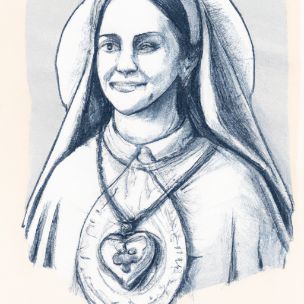 A second specific request of our Lady was that a Confraternity of Children of Mary be established. “Tell him who is in charge of you, though he is not your superior, that before long he will be entrusted with the care of the community in a special way.” Five years later Father Aladel was appointed Assistant to the Superior General of the Vincentians. He made use of his new authority to organize the Children of Mary. In 1847 Pope Pius IX authorized the organization as a Confraternity with all the indulgences. Sister Catherine knew that the organization was spreading throughout Europe and the world, but she did not betray her joy.
A second specific request of our Lady was that a Confraternity of Children of Mary be established. “Tell him who is in charge of you, though he is not your superior, that before long he will be entrusted with the care of the community in a special way.” Five years later Father Aladel was appointed Assistant to the Superior General of the Vincentians. He made use of his new authority to organize the Children of Mary. In 1847 Pope Pius IX authorized the organization as a Confraternity with all the indulgences. Sister Catherine knew that the organization was spreading throughout Europe and the world, but she did not betray her joy.
Catherine Labouré, the chosen messenger of the Blessed Virgin Mary, was almost entirely unknown outside her community, and within the community she was considered a person of rather mediocre talents. The description of her in the archives reads: “Catherine Labouré. Strong. Of medium height. Can read and write after a fashion. Seems to have good character. Her mind and powers of judgment are not outstanding; she is pious. Tries hard to be virtuous.“
It was thought that she had talent enough to cook for the old men in the Hospice d’Enghien in Paris and she was sent there in 1831. She remained there until her death in 1876. The installation of the new cook took place without attracting much attention. The old men had been quick enough to complain when they did not like the food, but under Sister Catherine there was nothing to complain about, and they took the food for granted.
Continuing a Humble Service to the Church
Sister Catherine found time for other things besides cooking. She performed many services for the old men. She took charge of the linen room and did wonders with her mending. The hen run and the dairy also came under her care, and she kept the accounts of cheese for thirty years. The spelling is strange in these accounts, but the handwriting is balanced and regular. Because she was so often h in the back yard with the hens she became known by the somewhat scornful title: “Sister of the hen run.” In her later years she suffered from coughing spells and from painful arthritis.
On every feast of the Blessed Virgin, she became ill or suffered in some manner. During the last sixteen years of her life she had a superior who was overly strict with her and reproached her for matters for which she was not responsible. Sister Catherine bore all such things with meekness and humility.
The Blessed Virgin had said to her: “You will have much to suffer, but you will over come that by realizing that you do so for the love of God… .” But her greatest suffering came because the third request of the Blessed Virgin had not been carried out. In addition to the Miraculous Medal and the Children of Mary, our Lady wished a statue of herself holding the world in her hands and looking up as if she were offering it to God. She had appeared in this position during several apparitions.
Father Aladel moved slowly in the matter. He had some preliminary drawings made, but he died in 1865 before work on the statue could begin. Sister had to begin all over again with her new spiritual director, Father Chinchon. In 1876, he was moved to another post, and the statue still had not been made. Sister Catherine was miserable. She was now seventy years old and did not feel that she could start again with a third spiritual director.
She first asked permission of the Blessed Mother and then sobbingly told her story to her superior, who had previously been so unsympathetic. It was the first time she had disclosed her secret to anyone except her spiritual adviser. The superior, her eyes now opened, gave her con sent and ordered the work to go ahead at full speed. A model of the statue was made. Catherine trembled with joy when she saw it, but she also said: “Oh, but Our Lady was so much more beautiful than that!” The statue was completed and placed above the high altar where our Lady had appeared. Sister Catherine’s last duty had been performed. She had said that she would not live to see 1877, and she died on December 31, 1876

St. Catherine Laboure an Incorruptible
Today, her incorrupt body lies in state under the statue of the Virgin Most Powerful, the statue which she called the “torment” of her life On Sunday, July 27, 1947, the bells rang out from the dome of St. Peter’s to celebrate the fact that Catherine Labouré was being added to the Church’s roll of saints. The bells of Rome’s 400 other churches took up the joyful clamor which reverberated from the city’s seven hills.
And in the little village of Fain-les-Moutiers another bell rang, the same little bell which had announced Catherine Labouré’s baptism in 1806.
OTHER SAINTS OF THE SAME NAME:
- St. Catherine of Alexandria, 282-307. Virgin and martyr; patron saint of philosophers and needle workers. Feast Day: November 25.
- St. Catherine of Sweden, 1331-1381 Daughter of St. Bridget of Sweden, friend of St. Catherine of Siena; she carried on her mother’s work in founding a monastery in Vadstena. Feast Day: March 24.
- St. Catherine of Siena, 13471380 Great mystic, instrumental in bringing about the return of the popes from Avignon to Rome. Feast Day: April 30.
- St. Catherine of Genoa, 14471510 Widow who received revelations concerning purgatory. Feast Day: September 14.
Popular St. Catherine Laboure Medal and St. Catherine Laboure Rosary
Prayers to St. Catherine Laboure
Prayer to St. Catherine Laboure
Dear St. Catherine Laboure,
Miraculous Virgin of the Miraculous Medal, we turn to you today in faith and trust. Your life was marked by devotion to the Virgin Mary and by your deep love for the poor. You worked tirelessly to serve the marginalized and to bring hope and comfort to those in need.
Through your intercession, we ask for the graces we need to grow in faith, hope and love. Help us to live a life of devotion to the Virgin Mary and to imitate her virtues of humility, purity and obedience.
May we also be moved by your compassion for the poor, and inspired to work tirelessly to bring comfort and hope to those in need.
Through your intercession, we ask for the healing of the sick, the comfort of the suffering and the protection of the vulnerable.
We pray in the name of Jesus, who lives and reigns with the Father and the Holy Spirit, one God, forever and ever. Amen.
Prayer for the Canonization of St. Catherine Laboure
Dear St. Catherine Laboure,
You lived a life of devotion and service to the Church, and were known for your deep love for the poor. Your unwavering faith and steadfast commitment to the gospel inspired many, and continue to do so to this day.
We ask for your intercession as we pray for the canonization of your life and work, that your memory may be honored and your teachings remembered.
May your life continue to inspire us to live a life of devotion, love, and service to others, especially the poor and marginalized.
Through your intercession, may we be granted the grace to deepen our faith, to grow in charity, and to bring the message of the gospel to all those we encounter.
We pray in the name of Jesus, who lives and reigns with the Father and the Holy Spirit, one God, forever and ever. Amen.
Prayer to Saint Catherine Laboure
Saint Catherine Labouré, you were the chosen confidant of the Blessed Virgin Mary. She revealed to you her desire that her children wear the Miraculous Medal as a mark of their love for her and in honor of her Immaculate Conception.
Intercede for us, that we may follow our heavenly mother’s desires. Ask that we may receive those special graces which flow from her motherly hands like rays of light. Amen
Prayer of Intercession to Saint Catherine Laboure
O Lord Jesus Christ,
Who hast deigned to strengthen the Virgin, Blessed Catherine,
by a wonderful vision of Thy Immaculate Mother;Grant, we bessech Thee,
that after the examples of tender devotion shown us by the same Blessed Catherine,
we may so honor Thy holy Mother as to obtain the joys of eternal life.Who liveth and reigneth with God the Father in the unity of the Holy Ghost,
one God, world without end.
Amen.
Prayer to Saint Catherine Laboure
O, St. Catherine,
Who by your filial confidence in the Blessed Virgin merited the privilege of contemplating
and conversing with Her while on this earth,
obtain for us a faith like yours in Her maternal love.Grant that we may understand and appreciate the value of silence and of humility,
and obtain for us the grace to show forth these virtues in our lives.Teach us to accomplish faithfully the duties of our state
in order that we may merit the happiness of contemplating with you,
the Virgin Immaculate during all eternity.
Amen.
Prayer to Saint Catherine Laboure
Immaculate Virgin Mary,
Mother of our Lord Jesus Christ and our Mother,
penetrated with the most lively confidence
in your all-powerful and never-failing intercession,
manifested so often through the Miraculous Medal,
we your loving and trustful children implore you
to obtain for us the graces and favors we ask during this Novena,
if they be beneficial to our immortal souls,
and the souls for which we pray:(Mention your request here…).
You know, Mary, how often our souls
have been the sanctuaries of your Son Who hates iniquity.
Obtain for us then a deep hatred of sin
and that purity of heart which will attach us to God alone
so that our every thought, word,
and deed may tend to His greater glory.Obtain for us also a spirit of prayer and self-denial
that we may recover by penance
what we have lost by sin
and at length attain to that blessed abode
where you are the Queen of Angels and of People.Amen.
St. Catherine Laboure: The Patron Saint of Miraculous Medals and Physical and Mental Sufferers
The life and legacy of St. Catherine Laboure
St. Catherine Laboure was born on May 2, 1806, in Fain-les-Moutiers, France. She entered the Daughters of Charity of St. Vincent de Paul, a religious congregation dedicated to serving the poor, in 1827. Throughout her life, Catherine was known for her devotion to God and her love for others, and she was remembered for her selfless service to the sick and the poor.
One of the most famous events in Catherine’s life took place in 1830, when she had a vision of the Virgin Mary. Mary appeared to Catherine three times and revealed to her the design for a medal that would come to be known as the Miraculous Medal. The Miraculous Medal features Mary standing on a globe, crushing a serpent beneath her feet, and surrounded by the words “”O Mary, conceived without sin, pray for us who have recourse to thee.”” The medal has become one of the most popular religious devotions in the Catholic Church, and it has been credited with many miracles and graces throughout the years.
Why is St. Catherine Laboure the patron saint of Miraculous Medals?
St. Catherine Laboure is the patron saint of Miraculous Medals because of her role in the creation and spread of the Miraculous Medal. The medal has become one of the most popular devotions in the Catholic Church, and it is credited with many miracles and graces throughout the years. As a result, Catherine is remembered as a powerful intercessor for those who wear the medal, and she is revered as the patron saint of those who seek the help and protection of Mary through the Miraculous Medal.
Why is St. Catherine Laboure the patron saint of physical and mental sufferers?
St. Catherine Laboure is the patron saint of physical and mental sufferers because of her life of service to the sick and the poor. Throughout her life, Catherine devoted herself to caring for those in need, and she was remembered for her compassionate and selfless service. As a result, she is revered as a powerful intercessor for those who are suffering, and she is remembered as a source of comfort and hope for all those who are struggling with physical or mental illness.
Reflection on the feast day of St. Catherine Laboure
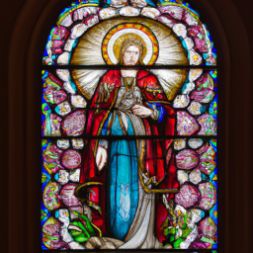 The feast day of St. Catherine Laboure is November 28th.
The feast day of St. Catherine Laboure is November 28th.
As we celebrate the feast day of St. Catherine Laboure, we are reminded of the importance of devotion and humility in our spiritual lives. St. Catherine Laboure was a French nun, who is known for her devotion to the Virgin Mary and her humility. She was also a mystic who had apparitions of the Blessed Virgin Mary, and it was through these apparitions that the Miraculous Medal was revealed to her.
As we reflect on St. Catherine’s life, we are reminded of the power of devotion in our own spiritual journey. She had a deep devotion to the Virgin Mary, and through this devotion, she was able to draw closer to God and find guidance and strength in her spiritual journey. Her devotion to Mary serves as a reminder that we too can turn to Mary in our own spiritual journey, and find comfort and guidance in her motherly love.
St. Catherine also reminds us of the importance of humility in our spiritual lives. She was a humble and unassuming woman, who was content to live her life in service to God and others. She never sought recognition or fame, but instead was content to live her life in quiet service. Her humility serves as a reminder that true spiritual growth and fulfillment come not from fame or recognition, but from a deep and humble relationship with God.
St. Catherine’s apparitions of the Virgin Mary and the revelation of the Miraculous Medal, also remind us of the power of devotion to Mary, and the importance of the sacraments in our spiritual lives. The Miraculous Medal is a powerful reminder of the power of God’s grace and protection, and the devotion to Mary through the medal serves as an invocation of her intercession and protection.
In this feast of St. Catherine Laboure, let us reflect on the importance of devotion and humility in our spiritual lives. May we be inspired by the example of St. Catherine and strive to deepen our devotion to the Virgin Mary and to live lives of humility and service. May we also be reminded of the power of the sacraments, particularly the Miraculous Medal and seek the intercession and protection of Mary through it. May we be filled with the grace and peace that come from a deep and humble relationship with God.
Discover biographies, prayers, and reflections for more than 400 Catholic Saints
Saints Similar to St. Catherine Laboure
You may also be interested in reading the Biography of St. Catherine of Siena and the Biography of St. Catherine of Bologna and the Biography of St. Catherine of Alexandria. Next up: Biography of St. Catherine of Alexandria
Also check out our handmade St. Catherine Laboure Medal and St. Catherine Laboure Rosary and St. Catherine Laboure Rosary Bracelet .

